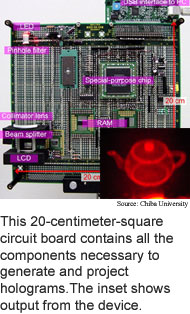
Chip miniaturizes holography
Researchers from Chiba University and the
Institute of Physical and Chemical Research (RIKEN) in Japan have built
a hologram generator on a single circuit board.
The device could eventually be used for three-dimensional television,
three-dimensional visualization of statistics, and three-dimensional medical
imaging.
The researchers' system consists of a special-purpose computer
chip and a high-resolution liquid-crystal display panel. The system generates
holograms on the screen with a half second delay for an object that consists
of 1,000 points, according to the researchers.
The key to generating a hologram in near real-time is being able
to compute a very large number of pixels very quickly. A good three-dimensional
picture must have a dot pitch, or pixel size, of less than than 5 microns
to look right to both eyes. A hologram that is 10 centimeters by 10 centimeters
with a 5-micron dot pitch contains 20,000 by 20,000 pixels.
A real-time reconstruction of an image with that many pixels requires
a computation speed faster than today's computers by one million times,
according to the researchers. The researchers' scheme speeds the computation
by programming the chip to calculate the data in parallel streams. The
scheme is also scalable; multiple chips can be used to increase the speed
of the system or the size of the image.
The device could be used in practical applications in five to
ten years, according to the researchers. The work appeared in the May
3, 2004 issue of Optics Express.
Fragments boost 3D TV
Internet ups power grid IQ
Fractals show machine intentions
VR tool re-creates hallucinations
Briefs:
Chip miniaturizes holography
Pressure adds depth to displays
Genes automate DNA machines
Scheme optimizes light chips
Silicon nanowires grown in place
Laser tweezer grabs varied specks

Research Watch blog
View from the High Ground Q&A
How It Works
RSS Feeds:
News
Ad links:
Buy an ad link
Ad links: Clear History
Buy an ad link
|
TRN
Newswire and Headline Feeds for Web sites
|
© Copyright Technology Research News, LLC 2000-2010. All rights reserved.